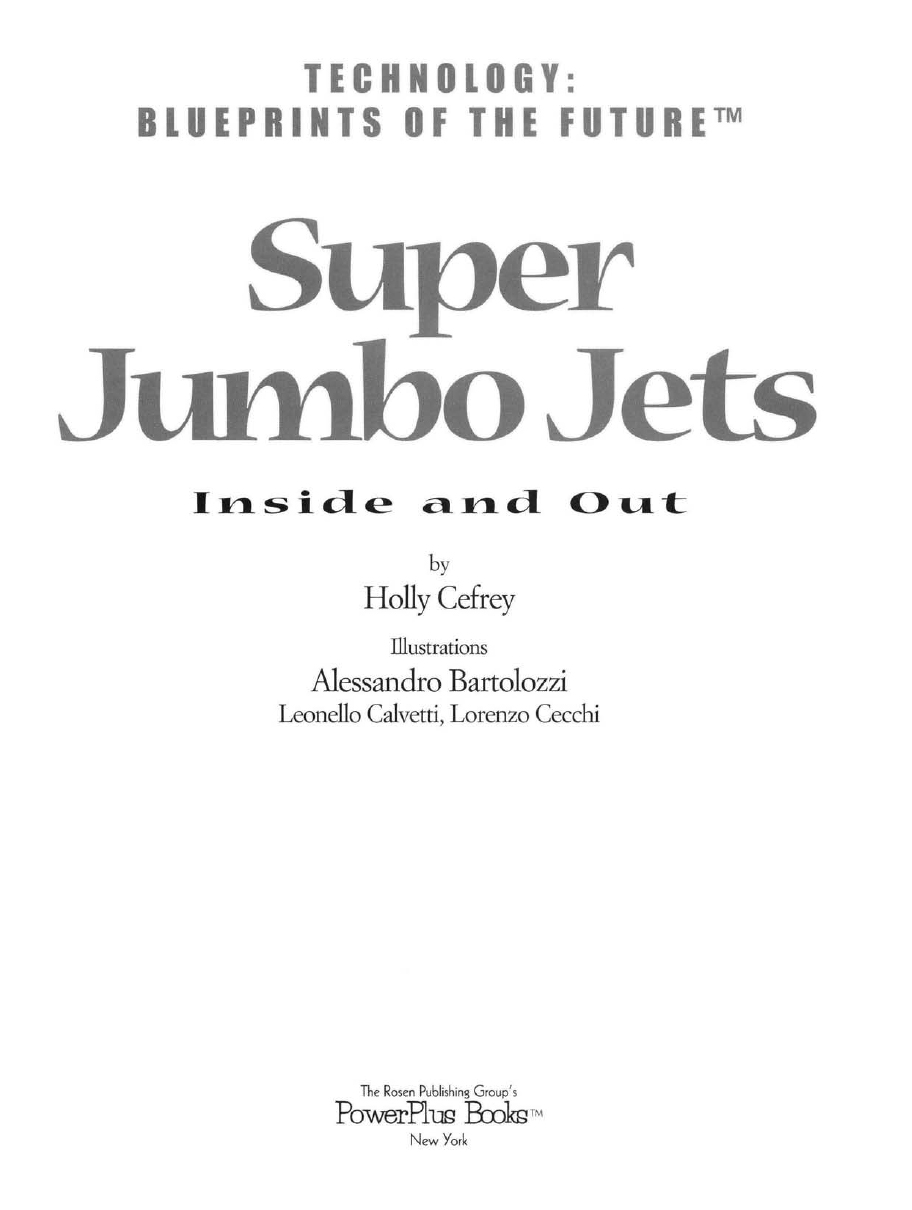This page intentionally left blank
Dedicated W.W.II Glider Pilot Theodore Cefrey
Copyright 2002
by Andrea Du s.r.l., Florence, Italy, and
Rosen Book Works, Inc., New York, USA
All rights reserved. No part of this book may be reproduced in any form
without permission in writing from the copyright holders, except by a reviewer.
Published in 2002 in North America
by The Rosen Publishing Group, Inc., New York
First Edition
Book Design:
Andrea Du s.r.l. Florence, Italy
Illustrations:
Alessandro Bartolozzi, Leonello Calvetti, Lorenzo Cecchi
Editor and Photo Researcher:
Joanne Randolph
Library of Congress Cataloging-in-Publication Data
Cefrey, Holly.
Super jumbo jets : inside and out / by Holly Cefrey. 1st ed.
p. cm. (Technologyblueprints of the future)
Includes bibliographical references and index.
Contents: To super jumbo, or not to super jumbo? - A Competition - Try, try again: humans in flight - Old rivalry, new planes - The Concorde - Forces of flight - The Airbus A380 - Jet engines: masters of thrust - Turbofan power - Looking inside a turbofan - Airbus cutaway - The jumbo generation - An international project - Construction - Super jumbo design - High-tech materials - Interiors - The future - Major Airlines of the World.
ISBN 0-8239-6112-5 (library binding)
1. Jet transportsJuvenile literature. [1. Jet transports. 2. Jet transports.]
I. Title. II. Series.
TK685.7 .C44 2002
629.133'349dc21
2002001744
Manufactured in Italy by Eurolitho S.p.A., Milan
To Super Jumbo or not to Super Jumbo?
Today, the sound of airplanes flying overhead is a familiar one. We have grown accustomed to planning trips in terms of hours rather than days, as we did in the days before commercial airline travel was a possibility for regular people. Flight has always been a dream of humankind, since Leonardo da Vinci designed a set of wings to be worn by a person and even before that. However, it has taken technological advances to make that dream a reality. Many people have contributed their ideas and knowledge to make this a safe transportation alternative. Commercial airliners have spent a lot of time and energy since then trying to affordably bring this possibility to as many people as possible. The size of airliners has grown by leaps and bounds. Airlines are continually trying to figure out how to get more people in the air, whether it be through more flights or through larger planes. The creation of a jumbo jet was a big step toward this goal. Not only did it allow airlines to transport more people, but it also opened new possibilities for shipping cargo. Even the space shuttle took a ride on a jumbo jet!

In 1977, a modified Boeing 747 was delivered to NASA for use as the delivery vehicle of the space shuttle.
The latest question in the world of commercial aviation is whether bigger or faster planes are the way to meet travelers demands. Both methods mean new technologies are needed to design new planes. Every time new technology surfaces in aviation, one of the biggest challenges is convincing travelers that the plane is safe. Despite these challenges a new super jumbo jet is being created by Airbus, and a plane that travels close to the speed of sound is in development by Boeing. Will there be enough people who want to travel by air to fill such big planes? Will people feel confident enough in the safety of a super-fast jet to take advantage of it? Only time will tell whether super jumbo jets or jets that cut down flying time are the wave of the future. Time will also tell what new technologies will bring to the world of flight. Where do you think the future of jumbo jets lies?

A Boeing 747 takes British Airways passengers to their destination. British Airways operates three versions of the Boeing 747: the series 400, 200 and 100. The airline operates 57 Boeing 747-400s including the new 747-400 Light Weight (Lite) aircraft. The 200 series are retired.
A Boeing 747 is nearing completion in the Boeing warehouse.
A Competition
Airplanes make it possible for us to travel great distances in just a matter of hours. Jet airplanes, which include supersonic jets and jumbo jets, are the latest and the fastest means of air travel.
Supersonic jets travel faster than the speed of sound. Think about when you snap your fingers. The sound of the snap travels to your ear almost instantly. The time that it takes the sound to travel from your finger to your ear is the speed of sound. Supersonic jets travel faster than the time it takes for you to hear your fingers snap. Supersonic jets have limits though. The number of passengers that these fast jets can carry is much less than the number that jumbo jets can carry. Supersonic jets are also very loud. This level of noise can be unhealthy for human ears.
Jumbo jets are large planes that take many passengers over great distances. Various plane builders make jumbo jets. The planes are sold to airline companies throughout the world. Airline companies such as Virgin, Air France, American, Lufthansa, Japan Airlines, and Singapore Airlines use jumbo jets. The airline companies use jumbo jets to deliver thousands of people to various destinations daily.
Just one of these big planes can carry more than 400 passengers in a single trip. Airline companies like this because having more passengers can mean more money for the company. Airline companies can get more passengers to their destinations by using bigger planes.
Planes have grown in size a lot. Notice how large the Boeing 747 (the gray drawing) is when compared to the Boeing 707 (the dark silhouette).
Over the next few years, jet planes are expected to get even bigger and better than the planes we have today. Two major jet plane builders are in a race to build the largest and fastest passenger planes ever. These companies are Airbus Industrie and the Boeing Company. Airbus is based in Europe, and Boeing is based in America.
Both companies have very different ideas about the future of air travel, or aviation. Airbus Industrie believes that the future lies in planes that are much larger than the jumbo jet. Boeing believes that the future lies in faster planes, which would cut down on travel time. The competition between Airbus Industrie and Boeing will lead to new and awesome planes, including larger, faster, and increasingly hightech planes.
This graph illustrates the productivity of the aeronautics industry over the past 50 years and projects productivity to 2020.

















